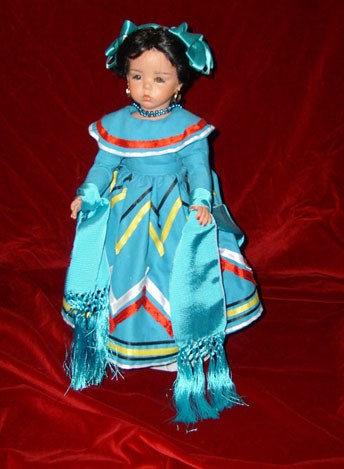
Capital: Durango Both the caped collar and full skirt of this brilliant blue dress are circled by distinctive white, yellow and red zigzags, perhaps mimicking the abrupt rise and fall of Durango's western landscape against its bright skies. The Sierra Madre Occidental and other smaller sierras traverse the western part of Durango, along with ravines and deep canyons, such as Las Quebradas. Northern Durango shares the flat and arid Mapimí Biosphere Reserve with the states of Chihuahua and Coahuila. (The term "biosphere" refers to living beings together with their environment.) In the narrow valley known as the Bolsón de Mapimí, diverse species of desert vegetation and animals, such as the desert tortoise, considered the largest tortoise of North America, are federally protected. Durango also has a biosphere reserve in La Michilía, in the southeastern municipality of Súchil, devoted to the study of deer, an abundant species in various regions of the state, but now in danger of extinction from uncontrolled hunting. Until 1800, the Mexican wolf was a common sight in the northern regions of Mexico. With the incursion of ranchers who view the wolf as a menace, the species is now all but extinct, appearing only occasionally in Durango and Chihuahua. Durango is one of Mexico's largest producers of goat's milk, along with poultry, cow's milk, and lumber from pine and oak. San Dimas and Otáez are known for gold and silver mines, and aquiculture in the Guadiana Valley produces carp and mojarra. Fairs scheduled along the agrarian calendar, such as the Canantlán Apple Fair and the San Juan del Río Nut Fair, promote regional products and agriculture. In the municipality of Nuevo Ideal, colonies of Mennonites - peaceful hard-working people whose European forefathers settled in Durango - are primarily dedicated to agriculture, and the manufacture of sausages and delicious cheese. The Tarahumara are concentrated in the Sierra Tarahumara (part of the Sierra Madre Occidental) in southern Chihuahua, which extends into northern Durango and Sinaloa. The Tarahumara are known for their amazing endurance as long-distance, often barefooted runners. Some Tarahumara have left the mountains seeking sustenance in urban areas, but many have remained in their remote homes, adhered to their traditions, and withstood drought and famine by cultivating corn, beans, and squash. Did you know...? 
Capital: Victoria de Durango Tanto el cuello como la larga falda de este brillante vestido azul están rodeados por costuras en zig zag de color blanco, amarillo y rojo, quizás imitando la abrupta subida y bajada del paisaje occidental de Durango contra el brillante cielo. La Sierra Madre Occidental y otras cadenas montañosas pequeñas atraviesan la parte occidental de Durango, con barrancos y cañones profundos, como Las Quebradas. El norte de Durango comparte le árida Reserva de Biosfera de Mapimí con los estados de Chihuahua y Coahuila (el término "biosfera" significa conjunto de los medios donde se desarrollan los seres vivos). En el estrecho valle conocido como el Bolsón de Mapimí, la flora y fauna del desierto, están protegidas federalmente, como la tortuga de desierto, considerada la más grande de Norteamérica. Otra Reserva de la Biosfera se ubicada también en Durango, se llama La Michilía, en el municipio de Súchil en el sudoeste del estado, dedicada al estudio del ciervo, especie abundante en varias regiones del estado, ahora en peligro de extinción por la caza incontrolada. Hasta el año 1800, el lobo mexicano era visto comúnmente en las regiones del norte de México. Pero con la iniciativa de los rancheros de eliminar al lobo porque lo veían como una amenaza para su ganado, la especie también está en peligro de extinción, ahora solo quedan unos cuantos ejemplares en Durango y Chihuahua. Durango es uno de los productores más grandes de México de leche de cabra, junto con las aves de corral, la leche de vaca y madera de pino y roble. San Dimas y Otáez son conocidos por sus minas de oro, plata y la pesca en el Valle de Guadiana de carpa y mojarra. Las ferias previstas en el calendario agrario, como la Feria de la Manzana en Canantlán y la Feria de las Nueces en San Juan del Río, promueven los productos regionales y la agricultura. En el municipio de Nuevo Ideal, las colonias Menonitas (gente pacífica trabajadora cuyos antepasados europeos se instalaron en Durango) se dedican principalmente a la agricultura y a la fabricación de salchichas y queso. Sabías que...? |
Last updated: February 24, 2015
